The best-selling book about the egg-sitting pachyderm is still in print, and so is one of two vintage recorded adaptations—both of which features the same distinguished narrator.
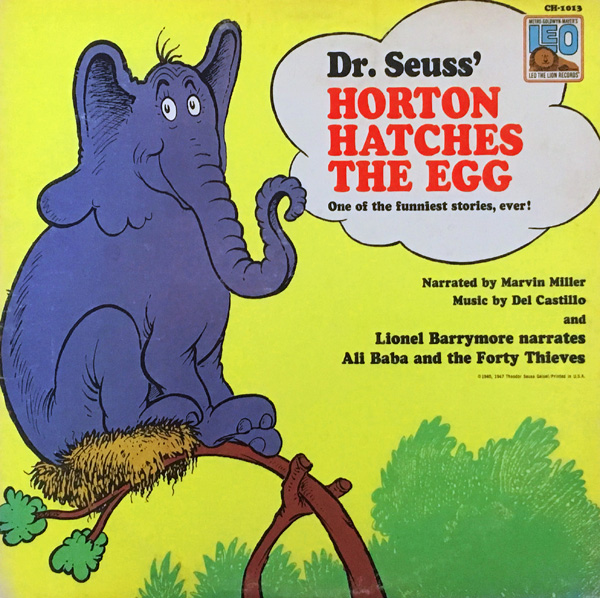
Dr. Seuss’
HORTON HATCHES THE EGG
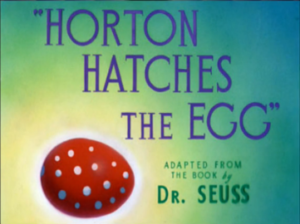 Narrated by Marvin Miller
Narrated by Marvin Miller
MGM Records L4-A (10” 78 RPM / 2 Discs / Mono)
LP Reissues: MGM Children’s Series CH- MGM Leo The Lion CH-1013 (Side Two: Lionel Barrymore Narrates Ali Baba and the Forty Thieves)
Released in 1947. Producer: Jesse Kaye. Running Time: 11 minutes.
Theodor Seuss Geisel’s long association with the Warner Bros. cartoon studio made it a natural fit for the staff to create one of their only cartoons based on a copyrighted, outside property. Having worked with Geisel successfully on the “Private Snafu” series for WWII soldiers, the author and the artists knew each other – and Bob Clampett directed this now classic adaptation in 1942. Narrated by Frank Graham (the voices of the Fox and Crow in Columbia’s cartoons) with Kent Rogers as Horton, Sara Berner as Mayzie and Mel Blanc doing incidental voices:
In Warner cartoon tradition, this version of Horton included a pop hit from the studio music library. The “Hut Sut Song” was a novelty tune (based on Swedish words) from 1941 that inspired several cover versions and found its way into subsequent films and TV shows such as A Christmas Story and The Muppet Show. It has nothing at all to do with the Seuss story, but that never stopped Termite Terrace from tossing a tune into a cartoon.
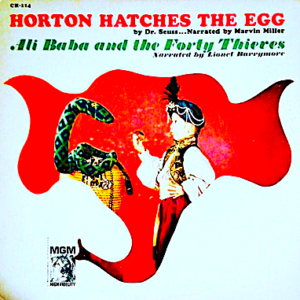 Five years later, MGM Records released a two-disc 78 RPM version of the best-selling children’s book, read by up-and-coming radio actor and announcer Marvin Miller. Animation fans will note that the music is by Del Castillo, a film, TV and theater organist who wrote the score for a dozen UPA cartoons, including Mister Magoo’s debut, Ragtime Bear.
Five years later, MGM Records released a two-disc 78 RPM version of the best-selling children’s book, read by up-and-coming radio actor and announcer Marvin Miller. Animation fans will note that the music is by Del Castillo, a film, TV and theater organist who wrote the score for a dozen UPA cartoons, including Mister Magoo’s debut, Ragtime Bear.
Miller’s work on MGM’s Horton recording may have given him an edge in being cast as narrator of UPA’s Oscar-winning Gerald Mc Boing-Boing (1950), another Dr. Seuss creation that we discussed in this Spin.
MGM Records reissued this Horton album on LP twice with another of its early children’s record sets, Ali Baba and the 40 Thieves, narrated by Lionel Barrymore (who was a frequent radio performer at the time, most famously as Scrooge in annual broadcasts of Dickens’ Christmas Carol). Unlike the RCA/Miller version, it has not been reissued on CD or download.
“Horton Hatches the Egg” (MGM Version)
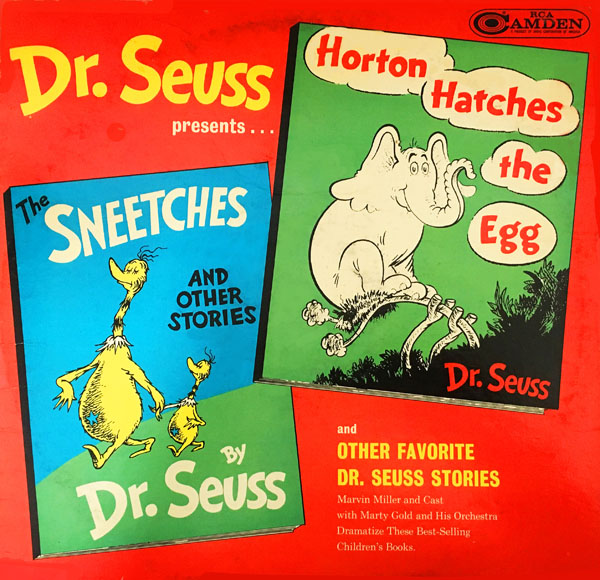
Dr. Seuss Presents
HORTON HATCHES THE EGG
Marvin Miller with Marty Gold and His Orchestra
RCA Camden CAS-1051 (Stereo) CAL-1051 (Mono) (12” 33 1/3 RPM LP) (Side Two: The Sneetches and Other Stories)
LP Reissues: Pickwick/RCA CAS-1051; RCA Music Service R-104106; also released in a two-record set called Dr. Seuss Favorite Children’s Stories and on various CDs
Currently available for download on iTunes and amazon
Released in 1964. Producer: Dr. Seuss (Ted Geisel). A&R Coordinator: Brad McCuen. Running Time: 13 minutes.
It’s reasonable to assume that Geisel was directly involved with the 1947 MGM Horton recording, So it may follow that Marvin Miller’s work on that record may have been a factor in his casting as narrator of the Gerald McBoing-Boing film. Likewise, his selection to narrate (and provide the character voices) for all the RCA albums may have also been a Seussian suggestion, since Geisel was the producer this time around.
In the late ‘50s/early’60s, Marvin Miller’s voice was, like Paul Frees, Ken Carpenter and Art Gilmore, heard consistently on television and movies, in commercials and in trailers. Marvin was also a familiar voice in animation. Here is Miller narrating the opening to Walt Disney’s 1959 animated feature, Sleeping Beauty (begins at 20:00),
Miller was a rare exception to the voice over career standard in that, like Mel Blanc, he was recognizable on screen as well, especially on the hit TV series The Millionaire (1955-1960), in which he played Michael Anthony, who distributed life-changing checks of one million dollars (this was the late 1950’s, remember) from billionaire philanthropist John Beresford Tipton. Viewers never saw Tipton—only his chair—but his voice was, who else? Paul Frees.
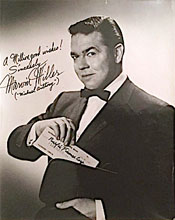 Like his peers, Miller came from radio and made a smooth transition into animation and announcing. Though his natural voice was often used for such characters as Robby the Robot in Forbidden Planet and Zarn on the Krofft series Land of the Lost, he could also do a number of character voices. When he was heard in the filler sequences for The Pink Panther Show, he not only narrated but also did the occasional character, like Tom-Tom the Piper son’s pig.
Like his peers, Miller came from radio and made a smooth transition into animation and announcing. Though his natural voice was often used for such characters as Robby the Robot in Forbidden Planet and Zarn on the Krofft series Land of the Lost, he could also do a number of character voices. When he was heard in the filler sequences for The Pink Panther Show, he not only narrated but also did the occasional character, like Tom-Tom the Piper son’s pig.
Frank Graham may have been the first actor to narrate a Seuss story for film in 1942 with Warner’s Horton cartoon. Boris Karloff arguably delivered the definitive performance of How the Grinch Stole Christmas in the 1966 Chuck Jones animated TV classic. Even Billy Crystal did a video version of Horton Hatches the Egg), accompanied by rudimentary animation of page art. But Marvin Miller topped them all—to this day–in sheer recording volume. Miller performed on four RCA Camden albums: Yertle the Turtle/Bartholomew and the Oobleck (1960); Horton Hatches the Egg/The Sneetches and Other Stories (1964); Fox in Socks/Green Eggs and Ham (1965); and If I Ran the Zoo/Sleep Book (1966). The last two albums won Grammy Awards (the following year, Karloff’s Grinch picked up the trophy).
Marty Gold, who wrote as well as conducted the music for all the albums, made the small orchestra sound nicely cartoony and satisfyingly full. Sometimes a low budget album’s music can betray its humble means, but these are charming in their simplicity. Gold was a veteran of RCA and other labels with dozens of children’s albums to his credit for Camden and Peter Pan in particular.
Geisel, Miller and Gold’s Dr. Seuss albums for RCA have rarely been off the market and are currently available for download.
“Horton Hatches the Egg” (RCA Camden Version)
Note that, in stereo, Miller’s character voices appear to be coming from the left and right channels, without seeming to be mere edits or physical moves. If an actor simply moves from one microphone to another to simulate stereo separation, the listener can discern the movement. The same is true when and editor just cuts a mono track from right to left. If the actor’s line overlaps from right to left or vice versa, the mono seams show. “Moving” tape hiss is also a giveaway. These albums sound as if—and this is only a guess–they actually went to the trouble of recording Miller’s dialogue and narration separately. Maybe that is why the cover lists “Marvin Miller and Cast,” as if his other voices were played by other actors, as a little nod to his talents.
Next Spin: Horton Hears a Who on Records


 GREG EHRBAR is a freelance writer/producer for television, advertising, books, theme parks and stage. Greg has worked on content for such studios as Disney, Warner and Universal, with some of Hollywood’s biggest stars. His numerous books include Mouse Tracks: The Story of Walt Disney Records (with Tim Hollis). Visit
GREG EHRBAR is a freelance writer/producer for television, advertising, books, theme parks and stage. Greg has worked on content for such studios as Disney, Warner and Universal, with some of Hollywood’s biggest stars. His numerous books include Mouse Tracks: The Story of Walt Disney Records (with Tim Hollis). Visit 





















































I remember watching the Beginner Book Video when I was a kid,TVHS around the time they were first reissued in the mid-90s.(Yes I am that young, and yes some of you I am that old.)
I wanted to see the Warners adaptation on CN in the early 2000s but I had to go to church as a kid 30 minutes away and didn’t have time to see the whole thing (or at least what the Cartoon Network censors deemed “the whole thing”).
I grew up on those videos too! They were recorded in New York, so they have such local stalwarts as Jim Thurman (best known for his work on Sesame Street and other CTW shows) as the voice of The Cat in the Hat, Earl Hammond, Ron Marshall, and Barton Heyman.
Better quality copy of the short here
https://www.metatube.com/en/videos/195775/Horton-Hatches-the-Egg-Cartoon-1942/